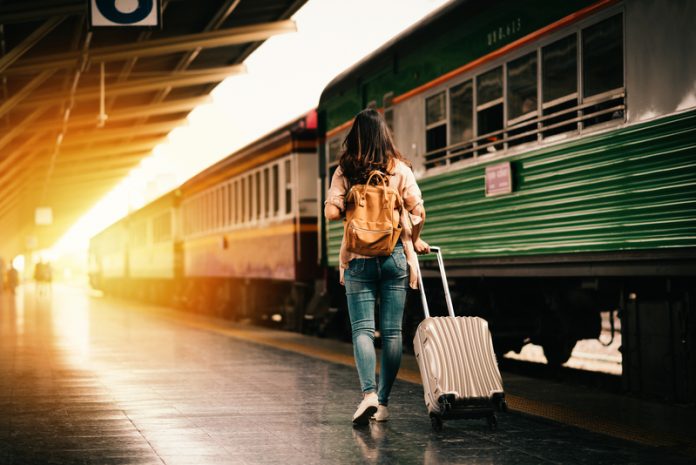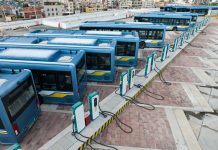Dave Ashton, CEO of Loco2, discusses what train stations will offer by 2030 thanks to technology and innovation
The rail industry is going through a revolution. It’s now easier than ever to buy your train tickets through apps and websites such as Loco2, to travel almost anywhere in Western Europe. Tickets are immediately available on your mobile device and live data in apps (on-time status, departure platforms, etc.) is becoming de rigueur. In many cities, you can tap your contactless bank card to pay for public transport, and of course Uber has reinvented the taxi sector.
And what about the train stations themselves? They too are modernising. Earlier this year I took an epic train journey in China, from Beijing in the north all the way to Hong Kong. More than 3500km in a long arc through Xian, Chengdu, Guilin and Shenzhen.
What impressed me most about the experience – beyond travelling overland at 300km an hour – was the train stations. Looking more like Heathrow Terminal 5 than St Pancras, their modern stores and restaurants accommodate tens of millions of passengers every year, with free Wi-Fi and comfortable lounges for those who want them. And it was clear they’ve planned significant additional modernisation projects.
China has had both the unfathomable challenge and beautiful luxury of building its transportation and communication infrastructure almost from scratch the last 25 years. That won’t happen in Europe: rail stations in major cities have been present since the 19th century. But there is still a lot of modernising to come in the next decade, to create a better passenger experience not just while we’re travelling, but to make life easier for the people who pass through the stations that are our departure and arrival points. That last bit might just be closer to reality than you think.
As a technology enthusiast and frequent traveller, I welcome any innovation or development that serves both growing rail demand and makes people’s lives better. And what’s coming will definitely do that. Not just for people in major cities but even for those in places further afield. The concept of a smart railway station, sometimes called “living transport hubs”, is coming soon.
Below is a list of my predictions of what train stations will offer us in the next decade
1) Sleepover stations
Train stations appeared during the Industrial Revolution, largely as soot-covered depots for trains to collect more coal and/or drop off passengers. The last thing anyone wanted was to sleep there. It’s not that way anymore – passengers want to be comfortable not just while they’re travelling, but during the waiting hours between connecting trains, too.
Within a few years’ time, I can imagine large sleeping islands appearing inside train stations for passengers to sit back and relax. Furthermore, in the next decade-plus, train stations will increasingly become not just mini-city/town centres, but people will want train stations to be their homes. Between now and 2030 more and more train stations – in cities large and small – will add housing that will become highly sought after given the good locations in which they’ll be placed.
2) Supermarket aisles
Craig Graeme, Transport for London’s director of commercial development believes the Transport system has the potential to be a “supermarket aisle” down which millions file every day. He said “They are time-poor people who’ve got very busy lives. All we need to do is work out what it is they need and give it to them in the most convenient format.”
Or imagine getting to your home train station parking lot and your groceries are bagged and waiting for you to pick up. Or better yet – already in your car. “Click and collect” services at London Underground stations in North London already do some of this, enabling commuters to purchase their shopping online in the morning and collect it on their way home via the station after 4pm. And also, the placing of Amazon or e-Bay lockers at stations, again for the collection of online purchases on the way home is surely an area of further growth potential for stations all over the world.
3) Takeaways on-demand
So grocery shopping via click and collect services is already available at some train stations, but what about takeaway and fast food? According to NPD Group, over the past decade, the takeaway delivery market has grown from £2.4 billion to a burgeoning channel worth £4.2 billion as of February 2018, a 73% increase.
With the unstoppable rise of the online food delivery phenomenon, train stations will increasingly collaborate with food delivery market leaders like Deliveroo, Just Eat or UberEats to offer passengers an on-demand takeaway service. Passengers could order their takeaway from their desired restaurant or fast food establishment via one of the partners’ apps and input the name of the train station they wish to collect their meals. Or who knows, maybe one day your meals will be delivered directly to your reserved seat, five minutes before your train departs!
4) Mobile health clinics
A new report by the British Heart Foundation urges the NHS (as part of its long-term plan) to place nurses across England’s train stations to offer general health checks, to help identify the millions of people with undiagnosed high blood pressure. I can envisage the NHS trialling mobile clinics in select train stations to encourage people to be more aware of their health and have easier access to services.
Train stations could partner with the NHS or private firms to integrate other medical facilities such as pharmacies, for commuters to pick up their prescription whilst on the go (this could be done via Boots or Superdrug).
5) Workout on your way
Trying to squeeze a daily workout at the gym is a common struggle for time-poor Britons (or maybe you’re just lazy, like me?). But what if your local train station had its own gym with ample space to workout, access to fitness equipment and facilities, and wait for it…a pool for that peaceful morning swim.
As train stations grow to become ‘living hubs’ for passengers, signs suggest they will incorporate personal services which are generally popular with people: fitness being high on the list. The gyms would work on a membership or pay-as-you-go basis to enable flexibility for users. I can see this becoming a trend amongst commuters who can replace rush hour travel with a workout.
6) Drop-in workspaces
In 2014, Network Rail and The Office Group announced they were opening three drop-in workspaces in King’s Cross, Liverpool Street and Leeds stations as part of joint venture The Station Office Network, an initiative intended to provide mobile offices in train stations throughout the UK’s major cities.
Though this was set-up four years ago, it’s only the beginning of what I see becoming the ‘norm’. Major stations across the country will be keen to attract workers who will use their amenities, and drop-in workspaces enable people to be flexible and productive before or after their journey. Based on the initiative, stations will naturally offer wifi/ broadband, private offices, meeting rooms, and shared drop-in desk areas, in order to suit a broad range of businesses and rail passengers.
7) Virtual ticketing agents
The concept of an innovative hybrid between a virtual walk-up ticket office and a ticket vending machine with a video-linked call centre is already being welcomed by some train stations. It has been trialled by the central station in Essen, Germany in cooperation with Essener Verkehrs-AG (EVAG), and this year Greater Anglia rolled out virtual ticketing agents across rural rail stations in East Anglia.
Ticketing, in particular, has seen rapid change in the last decade, with smartcard-based systems rapidly overtaking traditional paper tickets on many of the world’s major transport networks. The system of virtual ticketing agents is designed to provide all the benefits of the traditional manned ticket office with the streamlined operational advantages of vending machines. It’s much more effective than ticket machines, so I expect this service will be offered widely to rail passengers in the coming years.
8) Integration with other transport modes
As the idea of driverless cars starts to entice urban dwellers, there have been debates about whether these will replace high-speed rail, but I see it as an opportunity to collaborate. Stations represent an obvious focal point for those operating fleets of autonomous and connected vehicles (CAV) and their ability to assimilate this technology into the stations will be critical. Milton Keynes Central station is the UK’s first Smart Station Demonstrator for future innovations within the rail sector – they are testing the impact of automated buses and metro, private vehicles with automated parking, and driverless cars.











